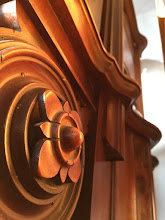
I managed to get a few fuzzy photos of the creature. I'm guessing this much be either a relatively new species to the Canadian prairies, or a very rare one at least. The bee is on Delphinium flowers about 3 cm in width. I estimate the bee to be about 3.5 to 4 cm in length (depending if you include wingtips).
UPDATE: Thanks to a tip from the Home Bug Gardener, the bee in the photo looks likely to be a queen bumble-bee. I later discovered my next door neighbour has a bee nest under her back step, the possible bee colony location for this queen. The bees are frequent visitors in particular to our oregano plant, where I typically see at least 10 bees feeding at any given time. However, the queen is rarely seen, this is only the second time in the last two years I've seen her.

In other news, we have been enjoying garden produce all summer, especially lettuce, spinach, volunteer lamb's quarter and chervil salads (I also include radish leaves, though the rest of the family does not care for them due to the small fuzz on them). Most plants are recovering from the hail except maybe the potatoes.













